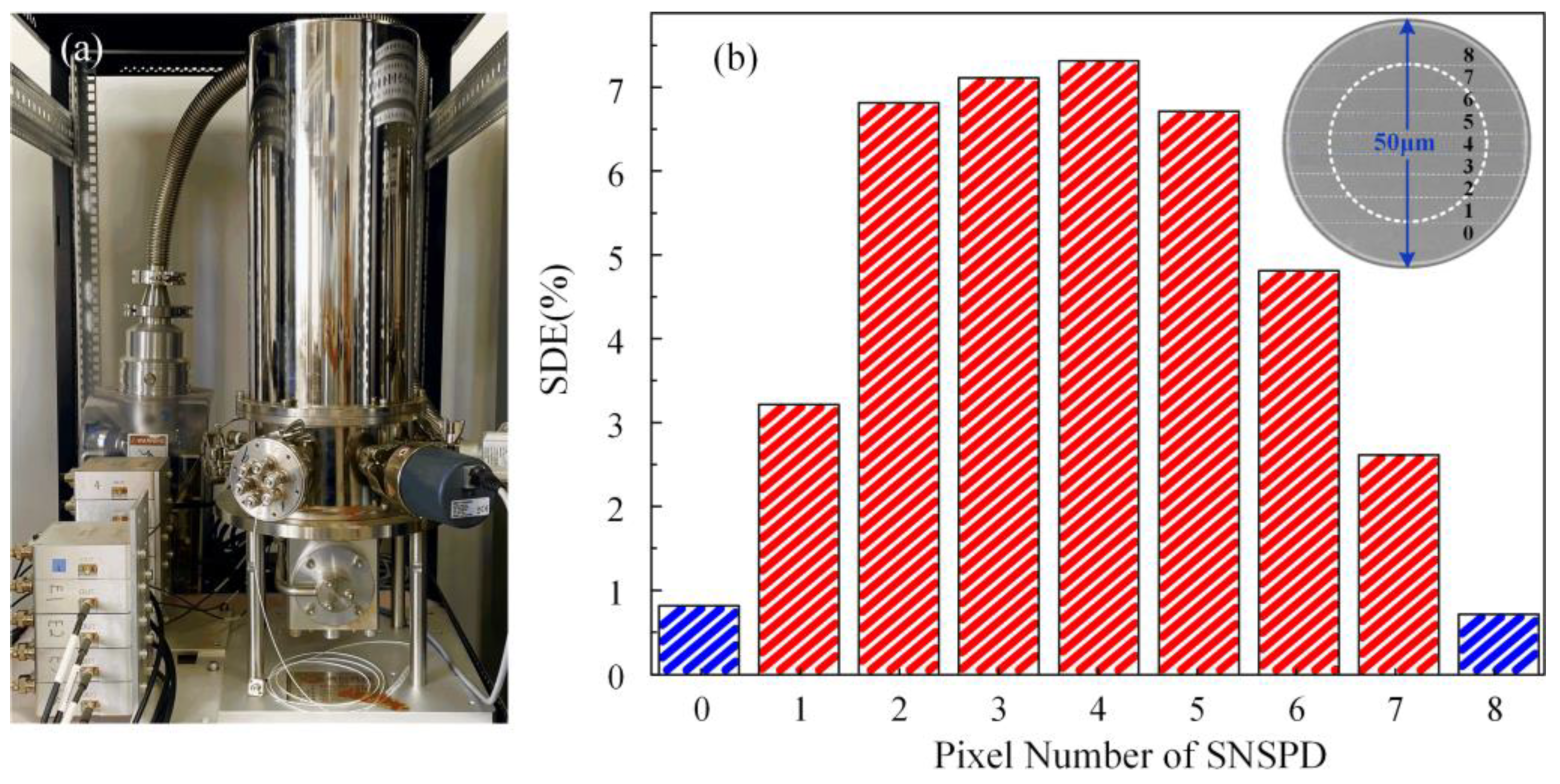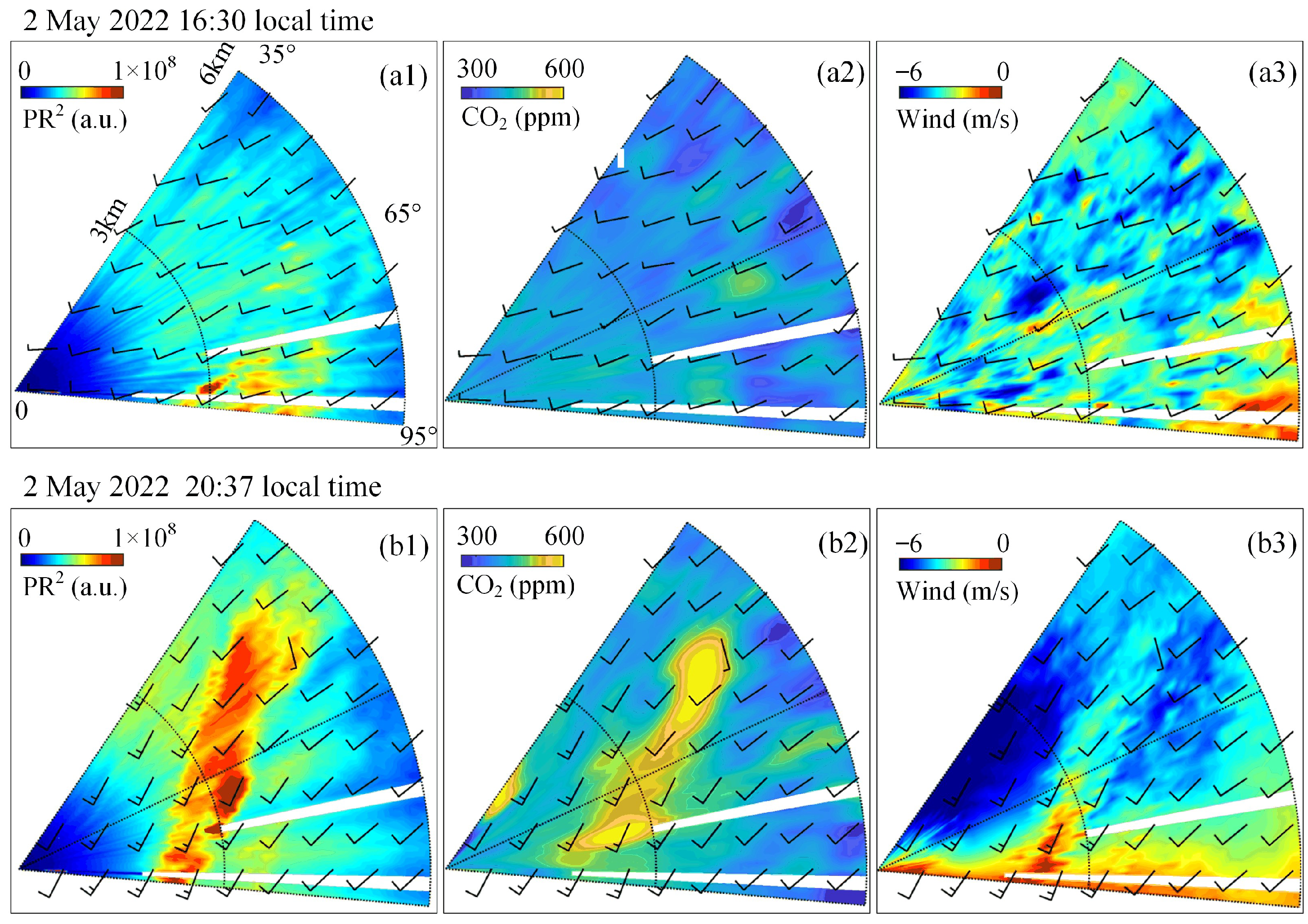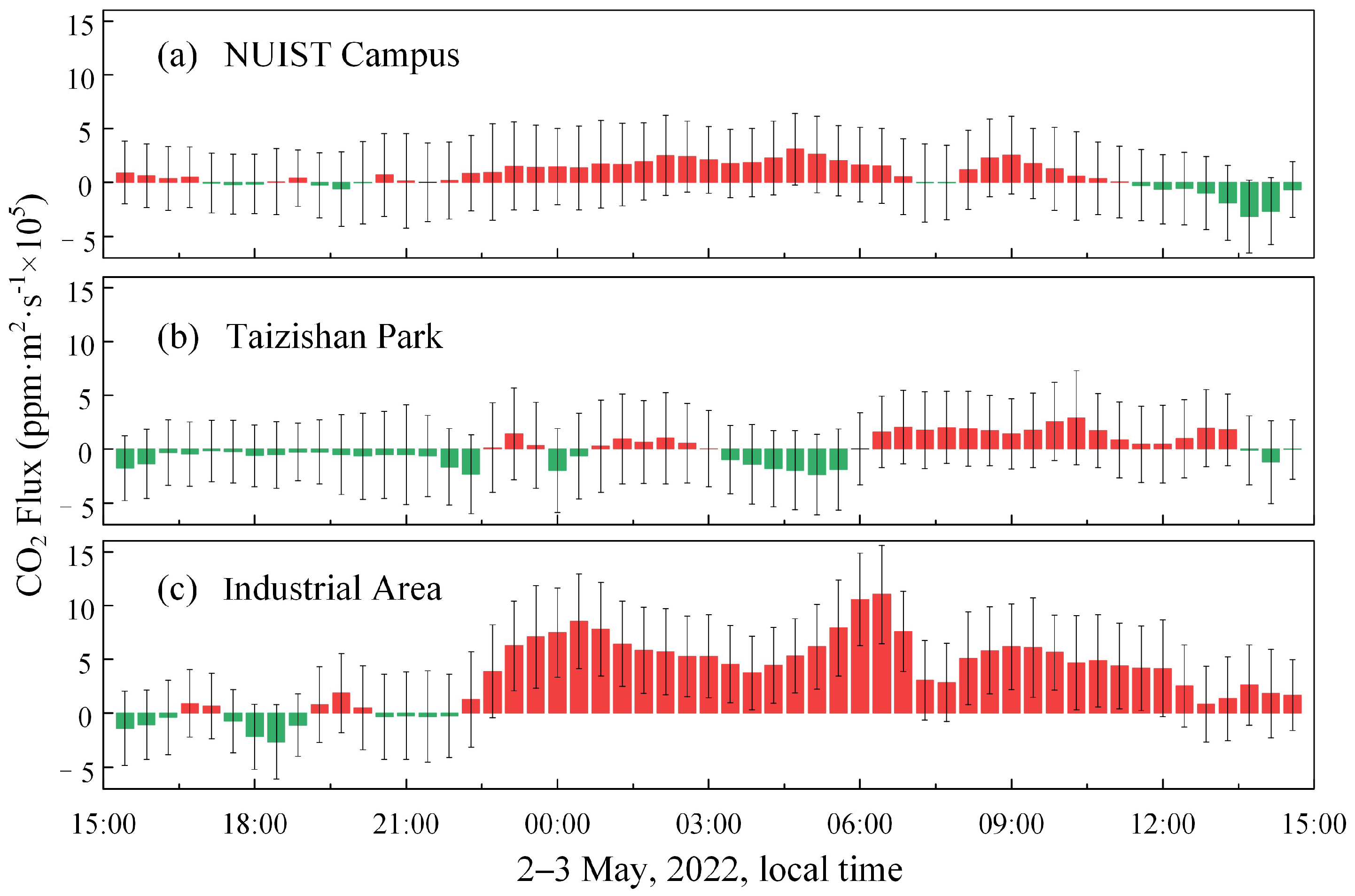Local-Scale Horizontal CO2 Flux Estimation Incorporating Differential Absorption Lidar and Coherent Doppler Wind Lidar
Abstract
1. Introduction
2. Instruments and Principles
2.1. Instruments
2.2. Advantages of the Hybrid Lidar
2.3. Principle
3. Optimization and Calibration of Optical Receiver
3.1. Mode Scrambling of Multimode Fiber
3.2. Temperature Control
4. Experiments and Results
4.1. Horizontal CO2 Distribution and Wind Field
4.2. Horizontal Net Flux
5. Conclusions
Author Contributions
Funding
Data Availability Statement
Acknowledgments
Conflicts of Interest
References
- Schmidt, K. Coming to Grips with the World’s Greenhouse Gases. Science 1998, 281, 504–506. [Google Scholar] [CrossRef]
- Metzl, N.; Tilbrook, B.; Poisson, A. The Annual FCO2 Cycle and the Air’sea CO2 Flux in the Sub-Antarctic Ocean. Tellus B Chem. Phys. Meteorol. 1999, 51, 849–861. [Google Scholar] [CrossRef]
- Gurney, K.R.; Law, R.M.; Denning, A.S.; Rayner, P.J.; Baker, D.; Bousquet, P.; Bruhwiler, L.; Chen, Y.-H.; Ciais, P.; Fan, S.; et al. Towards Robust Regional Estimates of CO2 Sources and Sinks Using Atmospheric Transport Models. Nature 2002, 415, 626–630. [Google Scholar] [CrossRef] [PubMed]
- Le Quéré, C.; Raupach, M.R.; Canadell, J.G.; Marland, G.; Bopp, L.; Ciais, P.; Conway, T.J.; Doney, S.C.; Feely, R.A.; Foster, P.; et al. Trends in the Sources and Sinks of Carbon Dioxide. Nat. Geosci. 2009, 2, 831–836. [Google Scholar] [CrossRef]
- Shi, T.; Han, G.; Ma, X.; Gong, W.; Chen, W.; Liu, J.; Zhang, X.; Pei, Z.; Gou, H.; Bu, L. Quantifying CO2 Uptakes over Oceans Using LIDAR: A Tentative Experiment in Bohai Bay. Geophys. Res. Lett. 2021, 48, e2020GL091160. [Google Scholar] [CrossRef]
- Wang, Q.; Mustafa, F.; Bu, L.; Zhu, S.; Liu, J.; Chen, W. Atmospheric Carbon Dioxide Measurement from Aircraft and Comparison with OCO-2 and CarbonTracker Model Data. Atmos. Meas. Tech. 2021, 14, 6601–6617. [Google Scholar] [CrossRef]
- Wang, J.; Feng, L.; Palmer, P.I.; Liu, Y.; Fang, S.; Bösch, H.; O’Dell, C.W.; Tang, X.; Yang, D.; Liu, L.; et al. Large Chinese Land Carbon Sink Estimated from Atmospheric Carbon Dioxide Data. Nature 2020, 586, 720–723. [Google Scholar] [CrossRef]
- Mustafa, F.; Bu, L.; Wang, Q.; Shahzaman, M.; Bilal, M.; Aslam, R.W.; Dong, C. Spatiotemporal Investigation of Near-Surface CO2 and Its Affecting Factors over Asia. IEEE Trans. Geosci. Remote Sens. 2022, 60, 1–16. [Google Scholar] [CrossRef]
- Wetzel, P.; Winguth, A.; Maier-Reimer, E. Sea-to-Air CO2 Flux from 1948 to 2003: A Model Study. Glob. Biogeochem. Cycles 2005, 19, GB2005. [Google Scholar] [CrossRef]
- Running, S.W.; Baldocchi, D.D.; Turner, D.P.; Gower, S.T.; Bakwin, P.S.; Hibbard, K.A. A Global Terrestrial Monitoring Network Integrating Tower Fluxes, Flask Sampling, Ecosystem Modeling and EOS Satellite Data. Remote Sens. Environ. 1999, 70, 108–127. [Google Scholar] [CrossRef]
- Cramer, W.; Kicklighter, D.W.; Bondeau, A.; Iii, B.M.; Churkina, G.; Nemry, B.; Ruimy, A.; Schloss, A.L. Comparing Global Models of Terrestrial Net Primary Productivity (NPP): Overview and Key Results. Glob. Change Biol. 1999, 5, 1–15. [Google Scholar] [CrossRef]
- Massman, W.J.; Lee, X. Eddy Covariance Flux Corrections and Uncertainties in Long-Term Studies of Carbon and Energy Exchanges. Agric. For. Meteorol. 2002, 113, 121–144. [Google Scholar] [CrossRef]
- Aubinet, M. Eddy Covariance CO2 Flux Measurements in Nocturnal Conditions: An Analysis of the Problem. Ecol. Appl. 2008, 18, 1368–1378. [Google Scholar] [CrossRef]
- Helliker, B.R.; Berry, J.A.; Betts, A.K.; Bakwin, P.S.; Davis, K.J.; Denning, A.S.; Ehleringer, J.R.; Miller, J.B.; Butler, M.P.; Ricciuto, D.M. Estimates of Net CO2 Flux by Application of Equilibrium Boundary Layer Concepts to CO2 and Water Vapor Measurements from a Tall Tower. J. Geophys. Res. Atmos. 2004, 109, D20106. [Google Scholar] [CrossRef]
- Schmitgen, S.; Geiß, H.; Ciais, P.; Neininger, B.; Brunet, Y.; Reichstein, M.; Kley, D.; Volz-Thomas, A. Carbon Dioxide Uptake of a Forested Region in Southwest France Derived from Airborne CO2 and CO Measurements in a Quasi-Lagrangian Experiment. J. Geophys. Res. Atmos. 2004, 109, D14302. [Google Scholar] [CrossRef]
- Baldocchi, D.; Falge, E.; Gu, L.; Olson, R.; Hollinger, D.; Running, S.; Anthoni, P.; Bernhofer, C.; Davis, K.; Evans, R.; et al. FLUXNET: A New Tool to Study the Temporal and Spatial Variability of Ecosystem-Scale Carbon Dioxide, Water Vapor, and Energy Flux Densities. Bull. Am. Meteorol. Soc. 2001, 82, 2415–2434. [Google Scholar] [CrossRef]
- Feigenwinter, C.; Bernhofer, C.; Eichelmann, U.; Heinesch, B.; Hertel, M.; Janous, D.; Kolle, O.; Lagergren, F.; Lindroth, A.; Minerbi, S.; et al. Comparison of Horizontal and Vertical Advective CO2 Fluxes at Three Forest Sites. Agric. For. Meteorol. 2008, 148, 12–24. [Google Scholar] [CrossRef]
- Vickers, D.; Thomas, C.; Law, B.E. Random and Systematic CO2 Flux Sampling Errors for Tower Measurements over Forests in the Convective Boundary Layer. Agric. For. Meteorol. 2009, 149, 73–83. [Google Scholar] [CrossRef]
- Lin, J.C.; Gerbig, C.; Wofsy, S.C.; Andrews, A.E.; Daube, B.C.; Grainger, C.A.; Stephens, B.B.; Bakwin, P.S.; Hollinger, D.Y. Measuring Fluxes of Trace Gases at Regional Scales by Lagrangian Observations: Application to the CO2 Budget and Rectification Airborne (COBRA) Study. J. Geophys. Res. Atmos. 2004, 109, D15304. [Google Scholar] [CrossRef]
- Wang, W.; Davis, K.J.; Cook, B.D.; Butler, M.P.; Ricciuto, D.M. Decomposing CO2 Fluxes Measured over a Mixed Ecosystem at a Tall Tower and Extending to a Region: A Case Study. J. Geophys. Res. Biogeosci. 2006, 111, G02005. [Google Scholar] [CrossRef]
- Wang, C.; Jia, M.; Xia, H.; Wu, Y.; Wei, T.; Shang, X.; Yang, C.; Xue, X.; Dou, X. Relationship Analysis of PM2.5 and Boundary Layer Height Using an Aerosol and Turbulence Detection Lidar. Atmos. Meas. Tech. 2019, 12, 3303–3315. [Google Scholar] [CrossRef]
- Amediek, A.; Ehret, G.; Fix, A.; Wirth, M.; Büdenbender, C.; Quatrevalet, M.; Kiemle, C.; Gerbig, C. CHARM-F—A New Airborne Integrated-Path Differential-Absorption Lidar for Carbon Dioxide and Methane Observations: Measurement Performance and Quantification of Strong Point Source Emissions. Appl. Opt. 2017, 56, 5182–5197. [Google Scholar] [CrossRef]
- Cezard, N.; Mehaute, S.L.; Gouët, J.L.; Valla, M.; Goular, D.; Fleury, D.; Planchat, C.; Dolfi-Bouteyre, A. Performance Assessment of a Coherent DIAL-Doppler Fiber Lidar at 1645 nm for Remote Sensing of Methane and Wind. Opt. Express 2020, 28, 22345–22357. [Google Scholar] [CrossRef]
- Yu, S.; Zhang, Z.; Li, M.; Xia, H. Multi-Frequency Differential Absorption Lidar Incorporating a Comb-Referenced Scanning Laser for Gas Spectrum Analysis. Opt. Express 2021, 29, 12984–12995. [Google Scholar] [CrossRef]
- Wagner, G.A.; Plusquellic, D.F. Multi-Frequency Differential Absorption LIDAR System for Remote Sensing of CO2 and H2O near 1.6 µm. Opt. Express 2018, 26, 19420–19434. [Google Scholar] [CrossRef]
- Cadiou, E.; Mammez, D.; Dherbecourt, J.-B.; Gorju, G.; Pelon, J.; Melkonian, J.-M.; Godard, A.; Raybaut, M. Atmospheric Boundary Layer CO2 Remote Sensing with a Direct Detection LIDAR Instrument Based on a Widely Tunable Optical Parametric Source. Opt. Lett. 2017, 42, 4044–4047. [Google Scholar] [CrossRef]
- Zhang, Z.; Xia, H.; Yu, S.; Zhao, L.; Wei, T.; Li, M. Femtosecond Imbalanced Time-Stretch Spectroscopy for Ultrafast Gas Detection. Appl. Phys. Lett. 2020, 116, 171106. [Google Scholar] [CrossRef]
- Xia, H.; Sun, D.; Yang, Y.; Shen, F.; Dong, J.; Kobayashi, T. Fabry-Perot Interferometer Based Mie Doppler Lidar for Low Tropospheric Wind Observation. Appl. Opt. 2007, 46, 7120–7131. [Google Scholar] [CrossRef]
- Kiemle, C.; Quatrevalet, M.; Ehret, G.; Amediek, A.; Fix, A.; Wirth, M. Sensitivity Studies for a Space-Based Methane Lidar Mission. Atmos. Meas. Tech. 2011, 4, 2195–2211. [Google Scholar] [CrossRef]
- Yu, S.; Zhang, Z.; Xia, H.; Dou, X.; Wu, T.; Hu, Y.; Li, M.; Shangguan, M.; Wei, T.; Zhao, L.; et al. Photon-Counting Distributed Free-Space Spectroscopy. Light Sci. Appl. 2021, 10, 212. [Google Scholar] [CrossRef]
- Hamperl, J.; Dherbecourt, J.-B.; Totems, J.; Mølster, K.M.; Canalias, C.; Lee, C.; Zukauskas, A.; Pasiskevicius, V.; Santagata, R.; Melkonian, J.-M.; et al. Preliminary Range-Resolved Detection of Stable Water Isotopologues by Differential Absorption Lidar Using a 2 µm Parametric Source. In Proceedings of the Optica High-Brightness Sources and Light-Driven Interactions Congress 2022, Budapest, Hungary, 21 March 2022; Optica Publishing Group: Washington, DC, USA, 2022. Paper MF3C.3. [Google Scholar] [CrossRef]
- Ansmann, A.; Riebesell, M.; Wandinger, U.; Weitkamp, C.; Voss, E.; Lahmann, W.; Michaelis, W. Combined Raman Elastic-Backscatter LIDAR for Vertical Profiling of Moisture, Aerosol Extinction, Backscatter, and LIDAR Ratio. Appl. Phys. B 1992, 55, 18–28. [Google Scholar] [CrossRef]
- Wulfmeyer, V.; Hardesty, R.M.; Turner, D.D.; Behrendt, A.; Cadeddu, M.P.; Di Girolamo, P.; Schlüssel, P.; Van Baelen, J.; Zus, F. A Review of the Remote Sensing of Lower Tropospheric Thermodynamic Profiles and Its Indispensable Role for the Understanding and the Simulation of Water and Energy Cycles. Rev. Geophys. 2015, 53, 819–895. [Google Scholar] [CrossRef]
- Giez, A.; Ehret, G.; Schwiesow, R.L.; Davis, K.J.; Lenschow, D.H. Water Vapor Flux Measurements from Ground-Based Vertically Pointed Water Vapor Differential Absorption and Doppler Lidars. J. Atmos. Ocean. Technol. 1999, 16, 237–250. [Google Scholar] [CrossRef]
- Kiemle, C.; Ehret, G.; Fix, A.; Wirth, M.; Poberaj, G.; Brewer, W.A.; Hardesty, R.M.; Senff, C.; LeMone, M.A. Latent Heat Flux Profiles from Collocated Airborne Water Vapor and Wind Lidars during IHOP_2002. J. Atmos. Ocean. Technol. 2007, 24, 627–639. [Google Scholar] [CrossRef]
- Engelmann, R.; Wandinger, U.; Ansmann, A.; Müller, D.; Žeromskis, E.; Althausen, D.; Wehner, B. Lidar Observations of the Vertical Aerosol Flux in the Planetary Boundary Layer. J. Atmos. Ocean. Technol. 2008, 25, 1296–1306. [Google Scholar] [CrossRef]
- Gibert, F.; Koch, G.J.; Beyon, J.Y.; Hilton, T.W.; Davis, K.J.; Andrews, A.; Flamant, P.H.; Singh, U.N. Can CO2 Turbulent Flux Be Measured by Lidar? A Preliminary Study. J. Atmos. Ocean. Technol. 2011, 28, 365–377. [Google Scholar] [CrossRef]
- Queiβer, M.; Granieri, D.; Burton, M. A New Frontier in CO2 Flux Measurements Using a Highly Portable DIAL Laser System. Sci. Rep. 2016, 6, 33834. [Google Scholar] [CrossRef] [PubMed]
- Robinson, R.A.; Gardiner, T.D.; Innocenti, F.; Finlayson, A.; Woods, P.T.; Few, J.F.M. First Measurements of a Carbon Dioxide Plume from an Industrial Source Using a Ground Based Mobile Differential Absorption Lidar. Environ. Sci. Process. Impacts 2014, 16, 1957–1966. [Google Scholar] [CrossRef]
- Bienfang, J.C.; Zwiller, V.; Steinhauer, S. Materials, Devices, and Systems for High-Speed Single-Photon Counting. MRS Bull. 2022, 47, 494–501. [Google Scholar] [CrossRef]
- Zhang, C.; Zhang, W.; You, L.; Huang, J.; Li, H.; Sun, X.; Wang, H.; Lv, C.; Zhou, H.; Liu, X.; et al. Suppressing Dark Counts of Multimode-Fiber-Coupled Superconducting Nanowire Single-Photon Detector. IEEE Photonics J. 2019, 11, 1–8. [Google Scholar] [CrossRef]
- Yuan, J.; Su, L.; Xia, H.; Li, Y.; Zhang, M.; Zhen, G.; Li, J. Microburst, Windshear, Gust Front, and Vortex Detection in Mega Airport Using a Single Coherent Doppler Wind Lidar. Remote Sens. 2022, 14, 1626. [Google Scholar] [CrossRef]
- Yuan, J.; Xia, H.; Wei, T.; Wang, L.; Yue, B.; Wu, Y. Identifying Cloud, Precipitation, Windshear, and Turbulence by Deep Analysis of the Power Spectrum of Coherent Doppler Wind Lidar. Opt. Express 2020, 28, 37406–37418. [Google Scholar] [CrossRef]
- Wei, T.; Xia, H.; Yue, B.; Wu, Y.; Liu, Q. Remote Sensing of Raindrop Size Distribution Using the Coherent Doppler Lidar. Opt. Express 2021, 29, 17246–17257. [Google Scholar] [CrossRef] [PubMed]
- Gordon, I.E.; Rothman, L.S.; Hargreaves, R.J.; Hashemi, R.; Karlovets, E.V.; Skinner, F.M.; Conway, E.K.; Hill, C.; Kochanov, R.V.; Tan, Y.; et al. The HITRAN2020 Molecular Spectroscopic Database. J. Quant. Spectrosc. Radiat. Transf. 2022, 277, 107949. [Google Scholar] [CrossRef]
- Zhang, W.J.; Zhang, C.J.; Huang, J.; Sun, X.Q.; Xu, G.Z.; Xiong, J.M.; You, L.X.; Wang, Z.; Xie, X.M. Development of Superconducting Nanowire Single-Photon Detector Arrays for Applications in SIMIT. In Proceedings of the Advanced Photon Counting Techniques XIV, Online, 28 May 2020; Volume 11386, pp. 45–54. [Google Scholar]









| Parameter | Value |
|---|---|
| On wavelength | 1572.335 nm |
| Off wavelength | 1572.454 nm |
| Pulse energy | 80 J |
| Pulse average power | 0.8 W |
| On/off pulse repletion frequency | 5 kHz |
| On/off laser frequency uncertainty | 0.5 MHz |
| Diameter of collimator | 80 mm |
| Diameter of telescope | 70 mm |
| Spatial resolution | 150 m |
| Radial temporal resolution | 15 s |
| Maximum range | 6 km |
| Azimuth scanning range | 0–360° |
| Zenith scanning range | 0–90◦ |
| SDE of SNSPD @ 1572 nm | 31.5% |
| Responsibility of BD | 1.0 A/W |
| Sample rate of ADC | 500 MS/s |
Publisher’s Note: MDPI stays neutral with regard to jurisdictional claims in published maps and institutional affiliations. |
© 2022 by the authors. Licensee MDPI, Basel, Switzerland. This article is an open access article distributed under the terms and conditions of the Creative Commons Attribution (CC BY) license (https://creativecommons.org/licenses/by/4.0/).
Share and Cite
Yue, B.; Yu, S.; Li, M.; Wei, T.; Yuan, J.; Zhang, Z.; Dong, J.; Jiang, Y.; Yang, Y.; Gao, Z.; et al. Local-Scale Horizontal CO2 Flux Estimation Incorporating Differential Absorption Lidar and Coherent Doppler Wind Lidar. Remote Sens. 2022, 14, 5150. https://doi.org/10.3390/rs14205150
Yue B, Yu S, Li M, Wei T, Yuan J, Zhang Z, Dong J, Jiang Y, Yang Y, Gao Z, et al. Local-Scale Horizontal CO2 Flux Estimation Incorporating Differential Absorption Lidar and Coherent Doppler Wind Lidar. Remote Sensing. 2022; 14(20):5150. https://doi.org/10.3390/rs14205150
Chicago/Turabian StyleYue, Bin, Saifen Yu, Manyi Li, Tianwen Wei, Jinlong Yuan, Zhen Zhang, Jingjing Dong, Yue Jiang, Yuanjian Yang, Zhiqiu Gao, and et al. 2022. "Local-Scale Horizontal CO2 Flux Estimation Incorporating Differential Absorption Lidar and Coherent Doppler Wind Lidar" Remote Sensing 14, no. 20: 5150. https://doi.org/10.3390/rs14205150
APA StyleYue, B., Yu, S., Li, M., Wei, T., Yuan, J., Zhang, Z., Dong, J., Jiang, Y., Yang, Y., Gao, Z., & Xia, H. (2022). Local-Scale Horizontal CO2 Flux Estimation Incorporating Differential Absorption Lidar and Coherent Doppler Wind Lidar. Remote Sensing, 14(20), 5150. https://doi.org/10.3390/rs14205150












